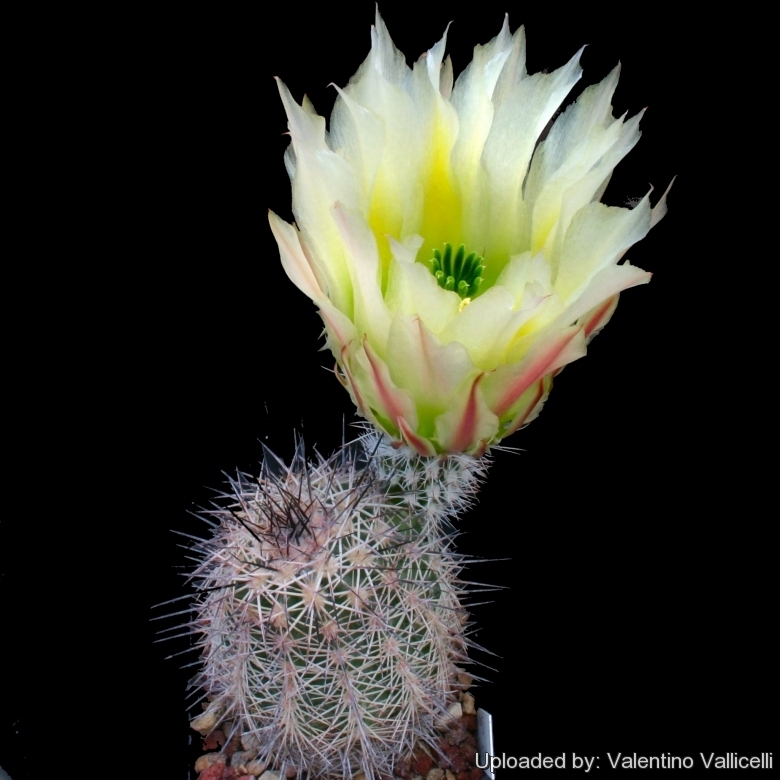Accepted Scientific Name: Echinocereus dasyacanthus Engelm.
Mem. Tour N. Mexico [Wislizenus] 100. 1848 Wisliz., Wisliz., Wisliz.

Echinocereus dasyacanthus var. rectispinus Photo by: Valentino Vallicelli
Origin and Habitat: North of Flores Magon to South of Villa Ahumada y Anexas, Chihuahua, Mexico
Habitat: It grows on low hills.
Synonyms:
See all synonyms of Echinocereus dasyacanthus
back
Accepted name in llifle Database:Echinocereus dasyacanthus Engelm.Mem. Tour N. Mexico [Wislizenus] 100. 1848Synonymy: 21
back
Common Names include:
ENGLISH: Yellow-flowered Pitaya, Golden Rainbow Hedghog Cactus, Yellow Pitaya, Rainbow Hedgehog
Description: Echinocereus dasyacanthus var. rectispinusSN|8509]]SN|21844]] is one of the morphological or local forms of Echinocereus dasyacanthusSN|5533]]SN|5533]] distinguished by having slightly longer brown, purplish, violet or black central spines. There are no other clear distinguishing features, and they must all be regarded as the same species.
Habit: Usually solitary or branching from the base, forming loose clumps of fewer than 20 stiff branches in old age, with its stem completely obscured by a layer of spines that can vary in colour depending on growing conditions. On some individuals, each year's new spines make a distinct band around the plant. The result is a stem with alternating bands of colour, vaguely suggesting a rainbow and similar to, but not as bold as, the Arizona Rainbow Cactus (Echinocereus rigidissimusSN|21844]]SN|8509]])
Stems: Ovoid, becoming cylindrical with age, upright, green, 10-20-(40) cm tall, 4-7(-10) cm in diameter.
Ribs: Straight, approx 15-20, crests rather sharply undulate.
Areoles: 3-5(-11) mm apart.
Spines: The stem is completely covered with short spines presenting a relatively bristly appearance. Annual growth increments are marked (often vaguely) by rings of spines with contrasting colours (depending on growing conditions) that grey with age.
Central spine: 3 to 10 central spines, up to 15 mm long, brown or purplish-black , straight, spreading in all directions.
Radial spines: Appressed, 16 to 24, up to 10 mm long pink to pale yellow, white, or tan, .
Flowers: 7-10 cm wide, 7-12 cm long; inner tepals, either yellow or rarely orange-yellow, salmon -pink to magenta with age, basal portion green in either case, tips relatively thin and delicate; The outer petals often have a darker or reddish midstripe. Anthers are yellow. The stigma has 16-20 lobes.
Flowering time: April-May.
Fruits: Dark, dull, purplish to maroon (sometimes remaining green), 2-3,5 cm, pulp white to purplish pink. The spiny fruits are edible, although acid.
Bibliography: Major references and further lectures
1) Edward Anderson “The Cactus family” Timber Press, Incorporated, 2001
2) James Cullen, Sabina G. Knees, H. Suzanne Cubey "The European Garden Flora Flowering Plants: A Manual for the Identification of Plants Cultivated in Europe, Both Out-of-Doors and Under Glass" Cambridge University Press, 11/Aug/2011
3) David R Hunt; Nigel P Taylor; Graham Charles; International Cactaceae Systematics Group. "The New Cactus Lexicon" dh books, 2006
4)Douglas B. Evans "Cactuses of Big Bend National Park" University of Texas Press, 1998
 Echinocereus dasyacanthus var. rectispinus Photo by: Valentino Vallicelli
Echinocereus dasyacanthus var. rectispinus Photo by: Valentino Vallicelli Echinocereus dasyacanthus var. rectispinus Photo by: Valentino Vallicelli
Echinocereus dasyacanthus var. rectispinus Photo by: Valentino VallicelliCultivation and Propagation: It is a summer grower species easy to cultivate, more cold tolerant than most and less fussy regarding soil conditions.
Growth rate: It is a relatively rapidly growing and easily flowering species that will make clumps given the best conditions.
Soils: It likes very porous standard cactus mix soil, but can become too elongated if compost is too rich.
Repotting: Use pot with good drainage.
Watering: Water regularly from Spring to Autumn, but do not overwater(Rot prone), keep dry in winter.
Fertilization: Feed with a high potassium fertilizer in summer.
Hardiness: Reputedly Very cold resistant to frost if kept on the dry side prior to, and during, cold weather (hardy to -10 C ° C, or less for short periods).
Exposition: Requires full sun or light shade and careful watering to keep plant compact with strong coloured spines. Tends to bronze in strong light, which encourages flowering and heavy spine production.
Uses: It is an excellent plant for container growing. It always looks good and stays small. It look fine in a cold greenhouse and frame or outdoor in a rockery.
Pests & diseases: It may be attractive to a variety of insects, but plants in good condition should be nearly pest-free, particularly if they are grown in a mineral potting-mix, with good exposure and ventilation. Nonetheless, there are several pests to watch for:
- Red spiders: Red sopiders may be effectively rubbed up by watering the infested plants from above.
- Mealy bugs: Mealy bugs occasionally develop aerial into the new growth among the wool with disfiguring results, but the worst types develop underground on the roots and are invisible except by their effects.
- Sciara Flies: Sciara flies are one of the major problems for seedlings. It is a good practice to mulch your seedlings with a layer of grit, which will strongly discourage the flies.
- Scales: Scales are rarely a problem.
- Rot: Rot is only a minor problem with cacti if the plants are watered and “aired” correctly. If they are not, fungicides won't help all that much.
Propagation: From seed or cutting (if available). Seeds germinate in 7-14 days at 21-27° C in spring, remove gradually the glass cover as soon the plants will be well rooted (ca 1-2 weeks) and keep ventilated, no full sun for young plants!












